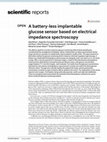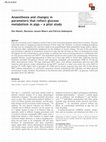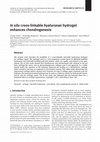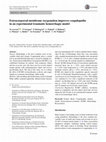Papers by Patricia Hedenqvist

Scandinavian Journal of Laboratory Animal Science, 2021
Mice (Mus musculus) have a high basal rate of metabolism which increases during pregnancy and lac... more Mice (Mus musculus) have a high basal rate of metabolism which increases during pregnancy and lactation. During peak lactation, water intake amounts to up to 65 % of the bodyweight per day. Providing water in a bottle may pose a restriction of water intake and lead to dehydration during periods of high demand, such as peak lactation. To establish if female mice are able to sustain a physiological hydration status during peak lactation, a completely randomized factorial design study was conducted with 12 RjOrl:SWISS (SWISS) and 12 C57BL/6JRj (B6) six-week old female mice in breeding. Female mice were randomly assigned to one of three groups with different watering alternatives: water bottle (Standard, n=6); water bottle + sachet with 98 % water gel (Gel, n=6); or water bottle + water bowl (Bowl, n=6). Non-mated females, provided with water bottles, served as controls (n=6). Hydration parameters [total protein (TP), hemoglobin, hematocrit, serum osmolality (Osmol), blood urea nitrogen (BUN)] and magnesium were measured in blood before mating (Pre) and during peak lactation (Peak), and at the same time points in controls. Water bottles were weighed during lactation and body weights of females and litters recorded at weaning. Data were analyzed by parametric or non-parametric methods to evaluate effects of strain, group and time point. The hydration parameters and magnesium were mostly within normal ranges in all animals at Pre and Peak. TP was lower at Peak in all lactating groups compared to Controls and to Pre (p<0.01). Mice in group Bowl consumed 54 % less bottle water compared with Gel and Standard (p<0.001), had 34 % lower levels of BUN than Standard and Control (p<0.01) and 5 % lower serum osmolality at Peak than Pre (p<0.01). Conclusion: Female mice are not dehydrated at peak lactation. However, they prefer to drink, and seemingly drink more water, from a bowl than from a bottle.

Laboratory Animals, 2013
Articular cartilage has a limited capacity for self-repair in adult humans, and methods used to s... more Articular cartilage has a limited capacity for self-repair in adult humans, and methods used to stimulate regeneration often result in re-growth of fibrous cartilage, which has lower durability. No current treatment option can provide complete repair. The possibility of growth factor delivery into the joint for cartilage regeneration after injury would be an attractive treatment option. A full thickness osteochondral defect of 4 mm in diameter and 2 mm deep was created by mechanical drilling in the medial femoral condyle in 20 female adult New Zealand White rabbits. In an attempt to improve regeneration a hyaluronic hydrogel system, with or without bone morphogenetic protein-2 (BMP-2) was delivered intraarticularly. The contralateral joint defect was treated with saline as control. Throughout the study, rabbits were clinically examined and after 12 (n ¼ 6) or 24 (n ¼ 9) weeks, the rabbits were euthanized and the joints evaluated by histology. The defects healed with fibrocartilage like tissue, and the filling of the defects ranged from less than 25% to complete. The healing of the defects varied both inter-and intra-group wise. Treatment with hyaluronan gel with or without BMP-2 had no effect on cartilage regeneration compared with controls. Instead, severe ectopic bone formation was found in seven joints treated with BMP-2. In conclusion, the present study shows that neither treatment with hyaluronic gel alone, nor in combination with BMP-2, improves the healing of an induced cartilage defect in rabbits. It further shows that BMP-2 can induce ectopic bone formation, which severely affects the functionality of the joint.

Laboratory Animals, 1999
The effects of induction of anaesthesia with sevoflurane and isoflurane were studied in rabbits. ... more The effects of induction of anaesthesia with sevoflurane and isoflurane were studied in rabbits. All rabbits had periods of apnoea (ranging from 30-180 s) during induction which resulted in moderate hypercapnia and acidosis. Arterial pC02 rose from 4.1 ± 0.3 kPa to a peak of 7.6 ± 0.4 kPa (mean ± SOl (both agents). All animals showed a significant reduction in heart rate (P < 0.051. Heart rate (HR) fell from 226 ± 33 to a minimum during induction of 57 ± 32 (sevoflurane) and 199 ± 41 to 45 ± 11 (isoflurane). Most animals struggled violently during induction. Use of sevoflurane did not prevent the breath-holding response seen during induction of anaesthesia with other volatile anaesthetics in this species, and the severe apnoea which occurs may represent a significant hazard. The behaviour of the animals indicated that both sevoflurane and isoflurane are aversive, suggesting that this technique should be avoided whenever possible.

Scientific Reports
The ability to perform accurate continuous glucose monitoring without blood sampling has revoluti... more The ability to perform accurate continuous glucose monitoring without blood sampling has revolutionised the management of diabetes. Newer methods that can allow measurements during longer periods are necessary to substantially improve patients’ quality of life. This paper presents an alternative method for glucose monitoring which is based on electrical impedance spectroscopy. A battery-less implantable bioimpedance spectroscope was designed, built, and used in an in vivo study on pigs. After a recovery period of 14 days post surgery, a total of 236 subcutaneous bioimpedance measurements obtained from intravenous glucose tolerance tests, with glucose concentration ranges between 77.4 and 523.8 mg/dL, were analyzed. The results show that glucose concentrations estimated by subcutaneous bioimpedance measurements correlate very well to the blood glucose reference values. The pigs were clinically healthy throughout the study, and the postmortem examinations revealed no signs of adverse ...
CRC Press eBooks, Oct 28, 2002

Laboratory Animals, Dec 15, 2016
Pigs are commonly used in diabetes research due to their many physiological similarities to human... more Pigs are commonly used in diabetes research due to their many physiological similarities to humans. They are especially useful in imaging procedures because of their large size. However, to achieve imaging procedures the pig must lie completely still, and thus needs to be anaesthetized. Most anaesthetic drugs used in laboratory animals affect carbohydrate metabolism by the inhibition of insulin release. The aim of this pilot study was primarily to develop an anaesthetic protocol for pigs that did not have an effect on blood glucose levels throughout the 3 h of anaesthesia; and secondly, to evaluate the most promising protocol in combination with an oral glucose tolerance test (OGTT). Two anaesthetic protocols were used in four growing pigs. Intravenous propofol infusion caused hyperglycaemia in three out of four pigs within 5-10 min after induction and was therefore excluded. Intravenous infusion with tiletamine, zolazepam and butorphanol (TZB) for 3 h did not affect blood glucose levels. The pigs underwent OGTT twice, once without anaesthesia and once with TZB induction after glucose intake. Anaesthesia during OGTT resulted in a lower area under the curve (AUC) of glucose (P < 0.05), higher AUC of glucagon (P < 0.05) and an insulin response less than 10% of that during OGTT without anaesthesia. In conclusion, long-term infusion anaesthesia with TZB does not affect glucose homeostasis in pigs. However, the protocol is not effective when combined with OGTT, as glucose, insulin and glucagon levels are affected.

Laboratory Animals, Apr 1, 2005
Twenty-one batches of fixed-formula rodent diets from three feed manufacturers were tested for th... more Twenty-one batches of fixed-formula rodent diets from three feed manufacturers were tested for the presence of five mycotoxins: deoxynivalenol (DON), nivalenol (NIV), HT-2 toxin, T-2 toxin and ochratoxin A (OTA). Five batches were also tested for the presence of zearalenone (ZEN) and six batches for aflatoxins. Detectable levels of DON (up to 298 mg/kg), NIV (up to 118 mg/kg), OTA (up to 3.1 mg/kg) or ZEN (up to 26.7 mg/kg) were found in samples from all manufacturers. Three batches contained two (DON or NIV and OTA or ZEN) and one batch contained three (DON, OTA and ZEN) different mycotoxins. Aflatoxins, T-2 and HT-2 were not detected in any of the batches. The concentrations of mycotoxins detected in the feed were low, but indicated that feed ingredients, probably the cereal ingredients, were contaminated by mycotoxins. Since mycotoxins are known to have toxic and/or immunosuppressive effects, non-contaminated ingredients should be used for production of laboratory animal feed. The results imply that an improved quality control of ingredients used for laboratory rodent feed should be implemented.

BMC Veterinary Research, 2013
Background: Anaesthesia in rabbits is associated with a high mortality rate, compared to that in ... more Background: Anaesthesia in rabbits is associated with a high mortality rate, compared to that in cats and dogs. Total intravenous anaesthesia (TIVA) with drugs that provide cardiovascular stability and are rapidly metabolised could be of benefit for use in rabbits. The aim was to evaluate cardiorespiratory effects of TIVA with sufentanil-midazolam in eight New Zealand White rabbits. Subcutaneous premedication with medetomidine (0.1 mg/kg BW) was followed by IV administration of a mixture of 2.5 μg/mL sufentanil and 0.45 mg/mL midazolam at a rate of 0.3 mL/kg BW/h for anaesthetic induction. Additionally, intravenous boluses of 0.1 mL of the mixture were administered every 20 s until the righting reflex was lost. Following endotracheal intubation, anaesthesia was maintained for 60 min with an infusion rate adjusted to supress the pedal withdrawal reflex. Air and oxygen (1:2) were delivered at 3 L/min. Physiological variables were recorded before induction and at predefined time points during and after anaesthesia. Results: Righting and pedal withdrawal reflexes were lost within 3 and 5 min, respectively. Doses of sufentanil and midazolam were 0.48 μg/kg BW and 0.09 mg/kg BW for induction, and 0.72 μg/kg BW/h and 0.13 mg/kg BW/h for maintenance. Apnoea occurred in two rabbits. Induction of anaesthesia caused a significant increase in heart rate, cardiac output and arterial CO 2 partial pressure and a decrease in mean arterial pressure, respiratory rate and pH. Mean time from stopping the infusion to endotracheal extubation was 5 min, and to return of the righting reflex 7 min. Anaesthesia was characterized by induction and recovery without excitation, with muscle relaxation, and absence of the pedal withdrawal reflex. Conclusions: TIVA with sufentanil-midazolam provided smooth induction and recovery of anaesthesia in rabbits but with marked hypotension and respiratory depression, requiring mechanical ventilation. Further evaluation is needed to establish if the protocol is useful for rabbits undergoing surgery.

Journal of Tissue Engineering and Regenerative Medicine, Mar 10, 2011
The present work describes the feasibility of a cross-linkable injectable hyaluronan hydrogel for... more The present work describes the feasibility of a cross-linkable injectable hyaluronan hydrogel for cartilage repair. The hydrogel used is a two-component system based on aldehyde-modified hyaluronan and hydrazide-modified polyvinyl alcohol, which are rapidly cross-linked in situ upon mixing. The in vitro study showed that chondrocytes and mesenchymal cells cultured in the gel form cartilage-like tissue, rich in glycosaminoglycans, collagen type II and aggrecan. In a rabbit animal model the injection of the hydrogel improved the healing of a full-thickness cartilage defect created in the knee as compared to non-treated controls. This rabbit study showed that the regenerated cartilage defects stained more intensely for type II collagen upon treatment with the hydrogel. The hyaluronan-based hydrogel may be used as a delivery vehicle for both growth factors and/or cells for cartilage repair. The in vivo study also indicated that the hydrogel alone has a beneficial effect on cartilage regeneration.
Journal of Veterinary Medical Education, Feb 25, 2019

Laboratory Animals, Apr 1, 2000
Two groups of rats were anaesthetized at weekly intervals for 6 weeks with either ketamine/medeto... more Two groups of rats were anaesthetized at weekly intervals for 6 weeks with either ketamine/medetomidine alone (60 mg/O.4 mg/kg i.p.) or ketamine/medetomidine (45 mg/0.3 mg/kg i.p.l one hour following buprenorphine (0.05 mg/kg s.c.). Animals that received buprenorphine had longer periods of surgical anaesthesia IP = 0.041 and a greater depression of both mean pedal withdrawal score (P < 0.01) and mean respiratory rate (P = 0.0141. Mean total duration of anaesthesia was also greater in the buprenorphine group on day 1. Sleep times reduced with successive doses of anaesthetic in the buprenorphine group (P=0.024). Two animals in the buprenorphine group died. Repeated anaesthesia with ketamine/medetomidine alone was not associated with anaesthetic mortality. These results indicate that although buprenorphine has a clear anaesthetic-sparing effect, its use with ketamine/medetomidine may be associated with an increased risk of anaesthetic-related mortality.

Veterinary Anaesthesia and Analgesia, 2001
OBJECTIVE To compare the characteristics of anaesthesia induced with four dose combinations of ke... more OBJECTIVE To compare the characteristics of anaesthesia induced with four dose combinations of ketamine/medetomidine. DESIGN Prospective randomized study. Animals Five female New Zealand White (NZW) rabbits of approximately 2.3 kg. METHODS Rabbits were given one of four drug combinations (25/0.25; 15/0.5; 15/0.25 and 10/0.5 mg kg-1 IM) on four successive occasions with a four day interval. Response to injection and then arterial blood gas and cardiovascular parameters were recorded at predetermined time points. Toe and ear pinch reflexes gave measures of total duration of surgical anaesthesia and total sleep time. Analyses used repeated measures analysis of variance. RESULTS Induction was smooth with little reaction to injection and intubation achieved easily. Two combinations (15/0.25, 10/0.5) produced moderate hypoxaemia (mean pO2 < 8.0 kPa) and two (25/0.25, 15/0.5) very marked hypoxaemia (mean pO2 < 5.3 kPa). This was reversed within 15 minutes of oxygen administration and all rabbits recovered uneventfully. Heart rates fell in all cases, with only minimal effects on arterial blood pressure and no cardiac arrhythmias. Mean duration of surgical anaesthesia was significantly longer for dose groups 25/0.25 (57 ± 12 minutes) and 15/0.5 (59 ± 17 minutes, p = 0.01) compared to dose group 15/0.25 (27 ± 8 minutes). Only three animals in the 10/0.5 mg kg-1 group achieved surgical anaesthesia. Mean duration of loss of the ear pinch reflex was similar between doses, being, respectively, 64 ± 13, 81 ± 7, 60 ± 22 and 62 ± 24 minutes. Sleep time was significantly longer for the 15/0.5 dose (112 ± 10 minutes) compared to 15/0.25 (86 ± 22 minutes, p = 0.04). Sleep times for the 25/0.25 and 10/0.5 mg kg-1 doses were, respectively, 103 ± 23 and 108 ± 12 minutes. CONCLUSIONS Ketamine/medetomidine reliably produces smooth induction and recovery in the NZW rabbit, but due to the degree of hypoxaemia produced, should only be used with simultaneous provision of oxygen. CLINICAL RELEVANCE Currently recommended dose rates of ketamine/medetomidine for minor procedures such as ovariohysterectomy in rabbits (25 mg/0.5 mg kg-1) are unnecessarily high; a dose of 15/0.25 mg kg-1 should be adequate for 15-30 minutes of surgical anaesthesia.
BMC Veterinary Research, Apr 16, 2021
The original article [1] contained an error in the naming of the boxplots in Fig. 4. This has sin... more The original article [1] contained an error in the naming of the boxplots in Fig. 4. This has since been corrected.

European Journal of Trauma and Emergency Surgery, Nov 4, 2016
and were hemorrhaged 45% of their estimated blood volume. After 90 min of hemorrhagic shock they ... more and were hemorrhaged 45% of their estimated blood volume. After 90 min of hemorrhagic shock they were resuscitated with a standard transfusion protocol together with venoarterial ECMO (n = 5) or with a standard transfusion protocol only (n = 5) for 60 min. No systemic heparin was administered. Results ECMO during 60 min of resuscitation significantly increased heart rate (p = 0.01), mean arterial pressure (p = 0.01), body temperature (p = 0.01) and improved the metabolic acidosis, pH (p = 0.01), and lactate (p = 0.01). ECMO also improved the coagulation capacity measured in vitro by Rotational Thromboelastometry with a significant decrease in clot formation time (p < 0.01). This finding was confirmed in vivo with a significant reduction in the animals' ear bleeding time (p < 0.01) and cuticle bleeding time (p < 0.01); 5/5 animals survived in the ECMO group and 3/5 animals survived in the control group. Conclusions Heparin-free ECMO stabilizes circulation, improves coagulation, and may impact short-time survival, during the first 60 min, in an experimental traumatic model with severe hemorrhagic shock.
ub.umu.se. Publications. ...

BMJ open diabetes research & care, Apr 1, 2021
Introduction Glucagon-like peptide-1 (GLP-1) increases insulin secretion from pancreatic beta-cel... more Introduction Glucagon-like peptide-1 (GLP-1) increases insulin secretion from pancreatic beta-cells and GLP-1 receptor (GLP-1R) agonists are widely used as treatment for type 2 diabetes mellitus. Studying occupancy of the GLP-1R in various tissues is challenging due to lack of quantitative, repeatable assessments of GLP-1R density. The present study aimed to describe the quantitative distribution of GLP-1Rs and occupancy by endogenous GLP-1 during oral glucose tolerance test (OGTT) in pigs, a species that is used in biomedical research to model humans. Research design and methods GLP-1R distribution and occupancy were measured in pancreas and gastrointestinal tract by ex vivo autoradiography using the GLP-1R-specific radioligand 177 Lu-exendin-4 in two groups of pigs, control or bottle-fed an oral glucose load. Positron emission tomography (PET) data from pigs injected with 68 Ga-exendin-4 in a previous study were used to retrieve data on biodistribution of GLP-1R in the gastrointestinal tract. Results High homogenous uptake of 177 Lu-exendin-4 was found in pancreas, and even higher uptake in areas of duodenum. Low uptake of 177 Lu-exendin-4 was found in stomach, jejunum, ileum and colon. During OGTT, there was no increase in plasma GLP-1 concentrations and occupancy of GLP-1Rs was low. The ex vivo autoradiography results were highly consistent with to the biodistribution of 68 Ga-exendin-4 in pigs scanned by PET. Conclusion We identified areas with similarities as well as important differences regarding GLP-1R distribution and occupancy in pigs compared with humans. First, there was strong ligand binding in the exocrine pancreas in islets. Second, GLP-1 secretion during OGTT is minimal and GLP-1 might not be an important incretin in pigs under physiological conditions. These findings offer new insights on the relevance of porcine diabetes models. How might these results change the focus of research or clinical practice? ► This study identified important differences in GLP-1 regulation and secretion between pigs and humans, which must be kept in mind when using pigs as animal model for diabetes. ► Studies investigating GLP-1R target distribution and occupancy, also in the gastrointestinal tract, can be safely and accurately performed in vivo using 68 Ga-exendin-4, both in pigs and humans.

Summary The characteristics of two techniques of face-mask induction of desurane anaesthesia (rap... more Summary The characteristics of two techniques of face-mask induction of desurane anaesthesia (rapid or slow) were compared with the effects of slow isourane induction in ® ve New Zealand White (NZW) rabbits. Slow induction used stepwise increments in vapour setting of 2% for desurane and 0.5% for isourane at 30 s intervals. All animals were anaesthetized using each technique according to a randomized block design with one week between treatments. Observations were made of the quality of induction (any struggling or periods of apnoea) and the latency to, and the duration of loss of the righting and toe pinch reexes recorded. Changes in respiratory rate, arterial blood gas and cardiovascular parameters were also recorded. Induction and recovery times were shorter with rapid desurane induction in comparison to isourane (loss of rightingreex: 139 27 s cf. 205 48 s), but both techniques were associated with struggling and long periods of apnoea ( >1 min) during the ® rst 4 min after a...
Animals, Jun 4, 2021
This article is an open access article distributed under the terms and conditions of the Creative... more This article is an open access article distributed under the terms and conditions of the Creative Commons Attribution (CC BY









Uploads
Papers by Patricia Hedenqvist